My last post here – Come, Let Us Explore Jajpur – was an introduction to the culturally and religiously significant but relatively lesser-known district of Jajpur. It is an ancient district located in the north eastern part of Odisha. The district has a fair share of remarkable heritage gems that deserve to be in the limelight and be appreciated for the treasure they are. I got the opportunity to travel to and explore parts of Jajpur district on Jajpur Administration’s invitation and it turned out be a wonderful opportunity to learn about the archaeological, spiritual and heritage treasure this region is home to. The first stop on this exploratory tour was the Biraja Devi Shakti Peeth located in Jajpur town.
Biraja Devi Shakti Peeth
Jajpur’s most significant claim to fame since ancient times is the Biraja Devi Shakti Peeth. This Shakti Peeth holds immense significance among the Hindus as it is one of the 18 Shakti Peeths where the body parts of Goddess Sati (the wife of Lord Shiva) fell after it was dismembered by Lord Vishnu. As per legend, Sati’s navel (nabhi in Hindi language) fell here. For the unversed, here is a little brief about the meaning of Shakti Peeth.
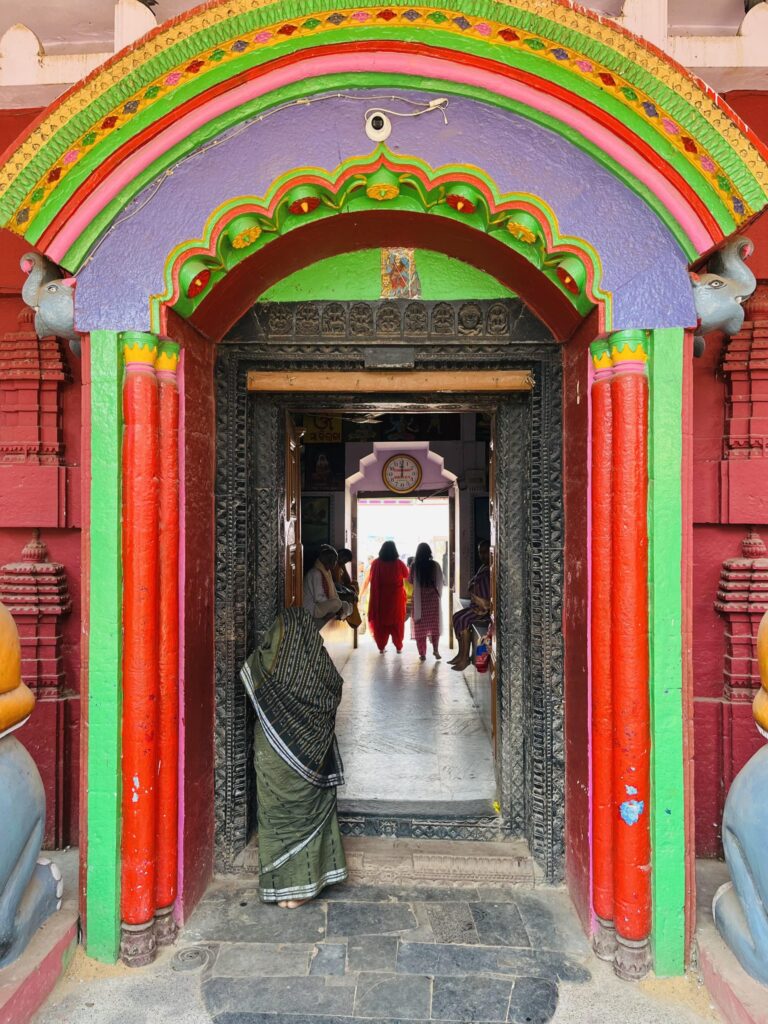
Brightly coloured Temple Entrance, Biraja Devi Shakti Peeth
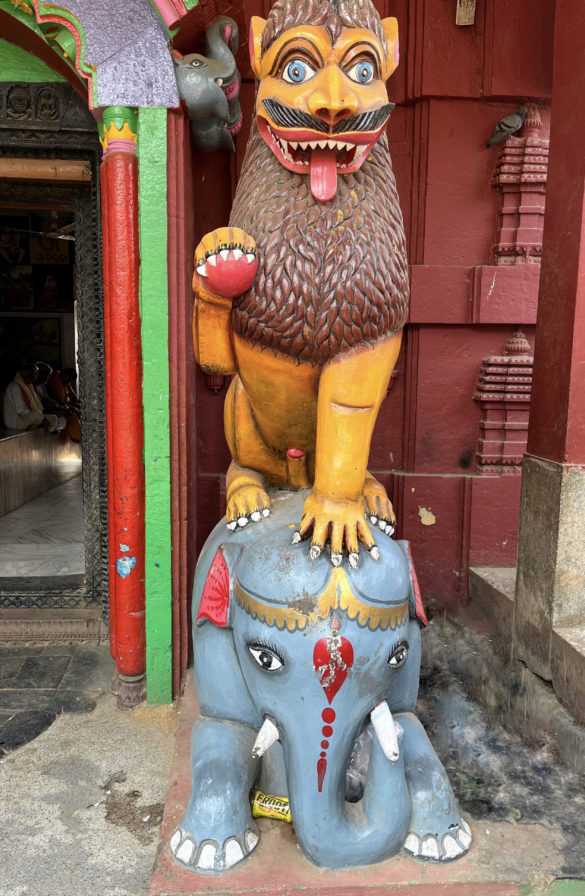
Lion subduing Elephant. Symbolic representation of Keshari Dyanasty’s dominance over Gajapati dynasty
What is a Shakti Peeth
As per Hinduism, Shakti Peeth is a seat of worship dedicated to Goddess Shakti – the epitome of female energy or feminine divinity in the cosmos. Ashtadasa Shakti Peeth Stotram, a sacred hymn composed by Sri Adi Shankaracharya mentions 18 Shakti Peeths and the names of the Goddesses worshipped there. Ashtadasa literally means eighteen. The number of peeths varies from 18, 51, 52, 64 to 108 as per different Hindu scriptures. Here, following Ashtadasa Shakti Peeth Stotram, I have mentioned 18 Shakti Peeths.
The Story Behind the Shakti Peeths
According to Hindu mythology, King Prajapati Daksha, the son of Lord Brahma, had a daughter named Sati. Princess Sati grew up being awestruck by the legends of Lord Shiva. When she grew up to be of marriageable age, it was only the ascetic Lord Shiva of Kailash whom she wanted to marry. When her father, King Daksha did not agree to this alliance, Sati left his palace and began meditation to win over Lord Shiva’s heart. She performed intense prayers in dense forests and renounced food. When she finally pleased Shiva through her austerity, the lord of Kailash appeared before her and agreed to marry her.
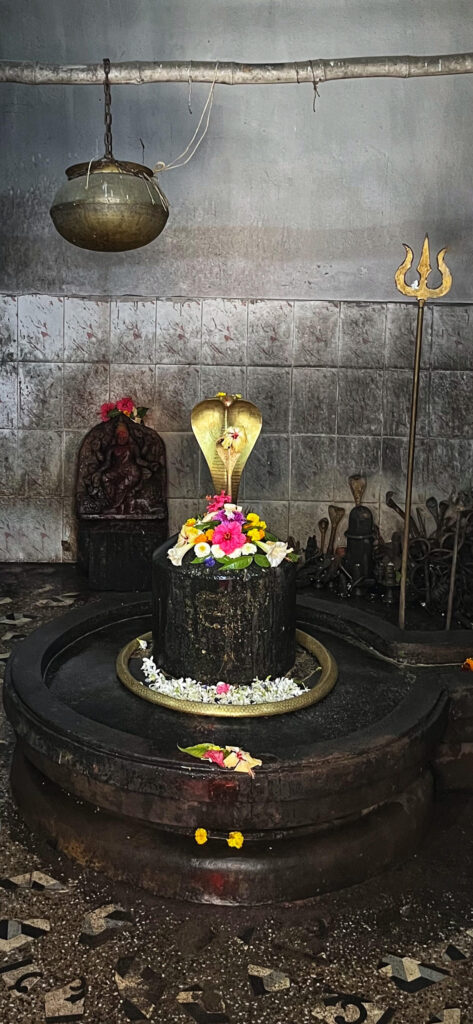
One of the Lord Shiva shrines inside the Biraja Devi Shakti Peeth
The legend goes that Sati and Shiva were happily married, but King Daksha was not pleased with his daughter for going against his will, and marrying a man whom he considered an ascetic not worthy of his daughter. Later, Daksha organized a great yajna (Yagya) with the intention of slighting Lord Shiva. He invited all the deities, gods, and sages, but consciously did not invite his daughter Sati and son-in law, Lord Shiva. The fact that she was not invited did not deter Sati from wanting to attend the yagna. She expressed her desire to attend her father’s yagna to Lord Shiva, who tried his best to dissuade her from going. But after persistent requests, Lord Shiva eventually allowed Sati to go to her father’s palace, escorted by his followers.
However, at the palace, Sati, being an uninvited guest, was not given any affection or respect by her father. Furthermore, King Daksha also insulted her husband, Lord Shiva. Unable to bear her father’s insults towards her husband, a devastated Goddess Sati invoked her yogic powers and immolated herself. Many ancient Hindu scriptures say she jumped into the holy yagna fire.
Lord Shiva’s Dance of Destruction
When Lord Shiva learned of the insult by his royal father-in-law Daksha, and his wife Sati’s subsequent self-immolation, he was enraged and created Veerbhadra from a clump of his matted lock of hair. Veerbhadra was instructed to create havoc in Daksha’s palace and destroy the yagna and all its participants. Veerbhadra followed Lord Shiva’s order and beheaded Daksha’s head, which was later resurrected with the head of the goat after Daksha begged forgiveness from Lord Shiva.
Still vengeful and immersed in grief, he picked up the remains of Sati’s body, and started the dance of destruction (Rudra Tandav) through the Universe. Alarmed that Lord Shiva’s tandav would destroy the world, Lord Vishnu used his Sudarshana Chakra to cut through the lifeless body of Sati. Her body parts fell at several places on earth and these formed the sacred sites which are now known as Shakti Peeths.
Maa Biraja Devi Shakti Peeth
Maa Biraja Devi Shakti Peeth or the Biraja Kshetra has many lore and legends associated with it. Sati’s navel is said to have fallen on this spot. Hence this place is also called Nabhi Gaya.
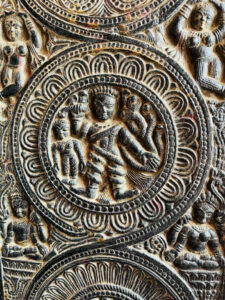
Carvings on the temple door, Biraja Devi Shakti Peeth
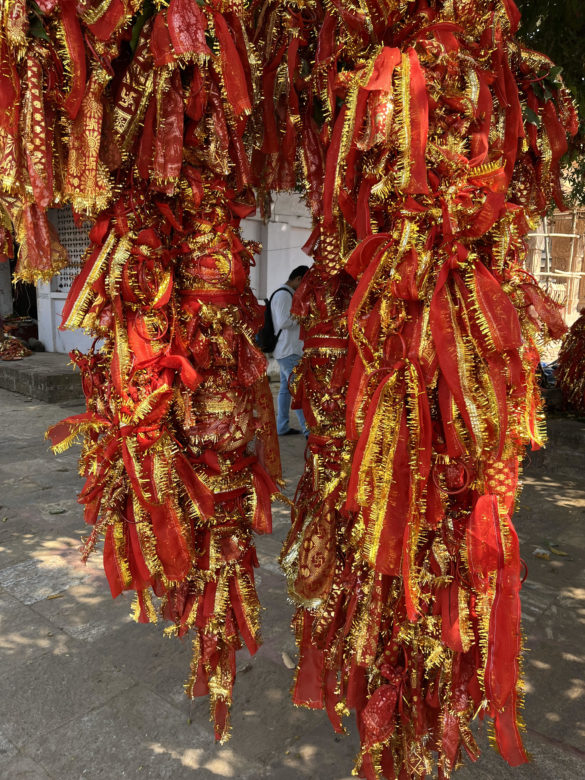
Sacred chunnis tied to the Holy Bakul tree inside the Biraja Kshetra
This Shakti Peeth is locally referred to as Biraja Kshetra. Kshetra in Hindi language means area. Biraja Kshetra is the sacred abode of Goddess Biraja, one of the many manifestations of Goddess Durga. Before being revered as Maa Biraja, the Goddess was worshipped here as Vindhyavasini Devi. How she came to be known and worshipped as Goddess Biraja makes for a fascinating lore.
Naming of Biraja Kshetra
The town of Jajpur finds mention in many ancient religious literatures such as Brahmanda Purana, Skanda Purana, and Kapila Samhita. As per Brahmanda Purana, one of the eighteen major puranas (religious scriptures) in Hindu religion, once Lord Brahma, the creator of the universe, organised a ceremonial yagna on the banks of the sacred river Baitarani to pray to Goddess Parvati. Moved by Lord Brahma’s deep reverence and rituals, Goddess Parvati emerged from the holy yagna fire and instructed Lord Brahma to name her Biraja. Lord Brahma prayed and requested the Goddess to stay on there as the divine consort of Lord Shiva. The Goddess granted his wish and decided to reside at the very same place as Goddess Biraja. This is the reason the area is also referred to as Biraja Kshetra.
Inside the temple’s garbhgriha or the sanctum sanctorum, Goddess’ idol is depicted as dwibhuja or with two hands. With one hand she is piercing the chest of demon Mahisasur, who is in the form of a buffalo, while her other hand is shown pulling the tail of the buffalo. The posture of this idol is considered a rarity, as at most Shakti Peeths, the Goddess is depicted having more than two hands. The present temple of the Goddess Biraja was built in the 13th century during the reign of Jajati Keshari, a prominent ruler of the Somvanshi Dynasty.
Koti Linga – Rooms Full of Shiva Lingas
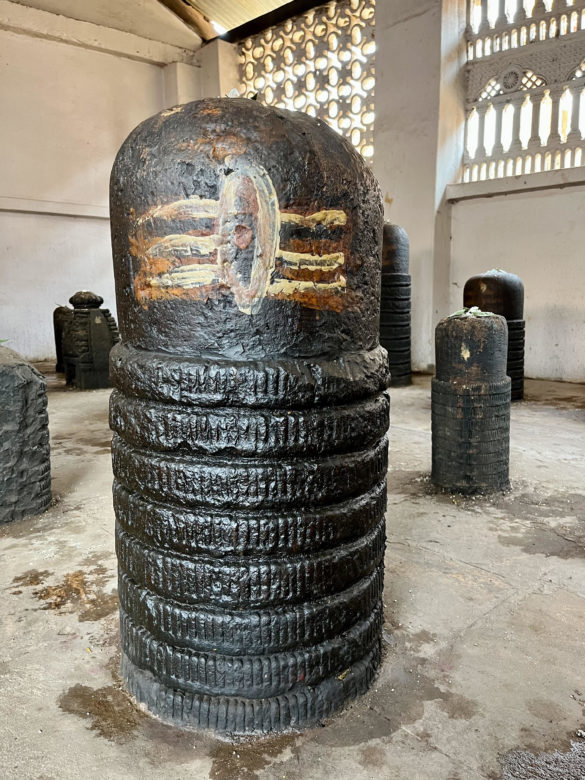
Sahastralinga carved on a shivling,
Besides the main temple, Biraja Devi Shakti Peeth temple complex has many smaller shrines dedicated to other deities of the Hindu pantheon. The complex also has two fascinating rooms right near the entrance of the temple, referred to as Koti Linga. They house several Shiva Lingas of different sizes. Many amongst these Shiva Lingas are Sahastralingas – miniature lingas carved on bigger sized lingas.
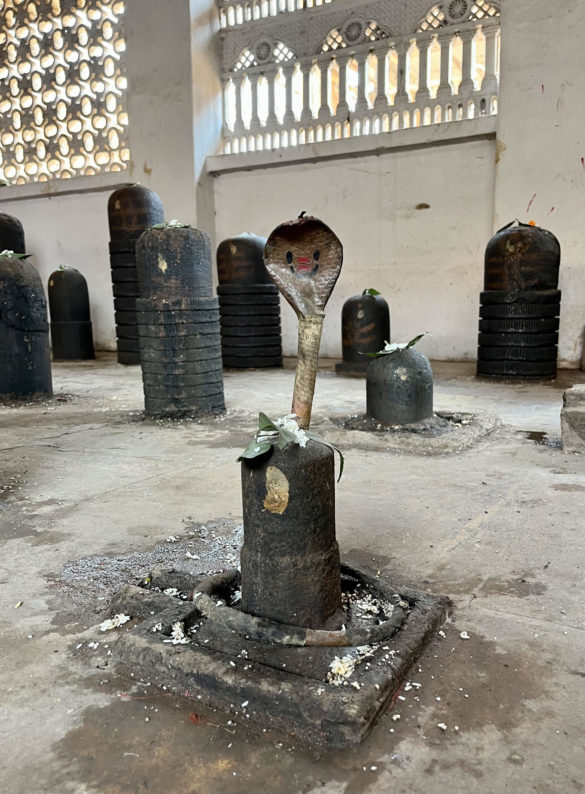
Room full of Shiva Lingas. Biraja Devi Shakti Peeth, Jajpur, Odisha
Legend has it that there are over 1 crore Shiva Lingas across Jajpur district, hence the term – Koti Linga. The Sanskrit word Koti means 1 crore in English. Outside the temple, just a few metres away, is a pond called Brahma Kund. It has steps across its edges and the place is green and serene, surrounded by palm trees.
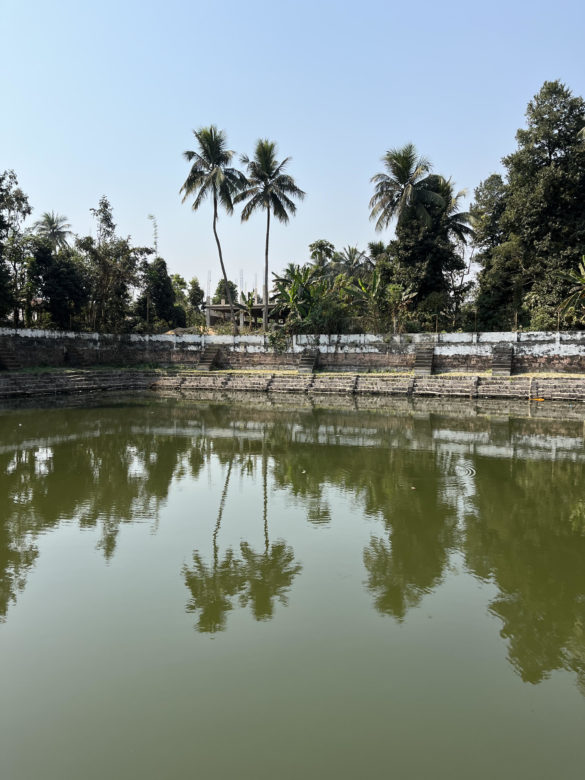
Brahma Kund. Biraja Kshetra, Jajpur, Odisha
Only if the temple heads focus a little on its upkeep and preservation, it will make for a beautiful area to sit and soak in the spiritual vibes of Biraja Kshetra.
Nabhi Gaya Well
While I found the rooms full of Shiv Lingas fascinating, another awe-inspiring corner of the Biraja Devi Shakti Peeth was the Nabhi Gaya well. Here post life rituals for the ancestors as advised in Hindu religion are performed. After the ceremonies such as Pind Daan, Pitra Puja, etc are performed, the remains of the rituals are put in the well from where they gradually keeps sinking down on their own.
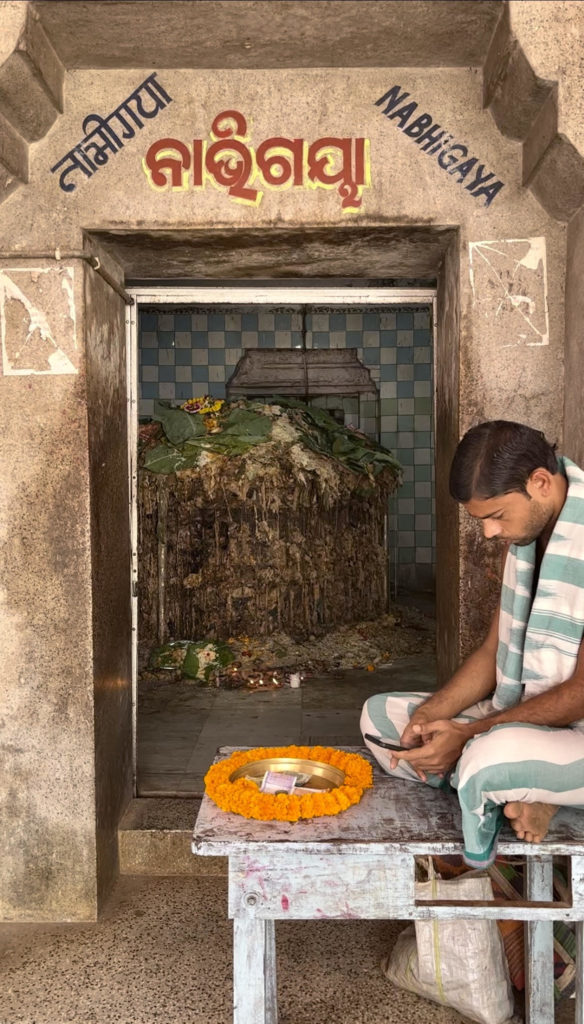
Nabhi Gaya Temple, Biraja Devi Shakti Peeth, Jajpur, Odisha,
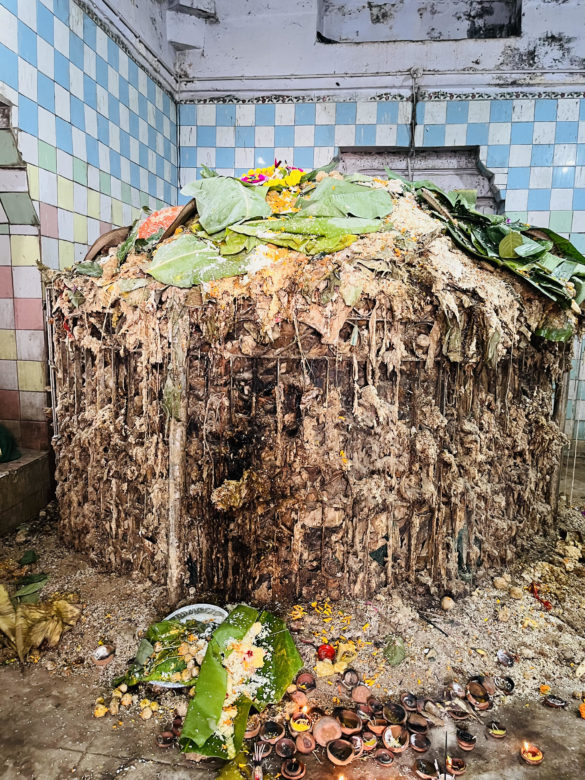
Nabhi Gaya Well, Biraja Devi Shakti Peeth, Jajpur, Odisha
According to Hindu mythology, Lord Vishnu killed a vicious asur or demon named Gayasur by performing a yajna (yagya) on his heart. While he laid on that yagna spot, his head was in Gaya in Bihar – referred to as Shiro Gaya, his feet were in Peethapuram in Andhra Pradesh – referred to as Pada Gaya, and his navel was right at this very place – referred to as Nabhi Gaya. According to the priests here, it is a popular legend that the well is connected to another world deep below the earth and that is where all the remains dumped from the ritualistic ceremonies sinks down to.
Maa Biraja Devi Rath Yatra
Sharadiya Durga Puja is one of the major festivals of this temple that is celebrated on Krishna Paksha Ashtami. During the Sharadiya Navratri or Durga Puja, Biraja Devi Shakti Peeth is the only Shakti Peeth in the country where the presiding deity has a 9-day Rath Yatra. Goddess Biraja is taken out in a chariot, accompanied by a procession on all the nine days of the festival. On the day of Vijayadashmi, ritualistic worship is done and a buffalo is sacrificed in reverence. Another day of great significance is Triveni Amavasya, when the birth anniversary of Biraja Devi is celebrated at the temple. These special occasions witness a massive influx of devotees who come to seek blessings of the Goddess.
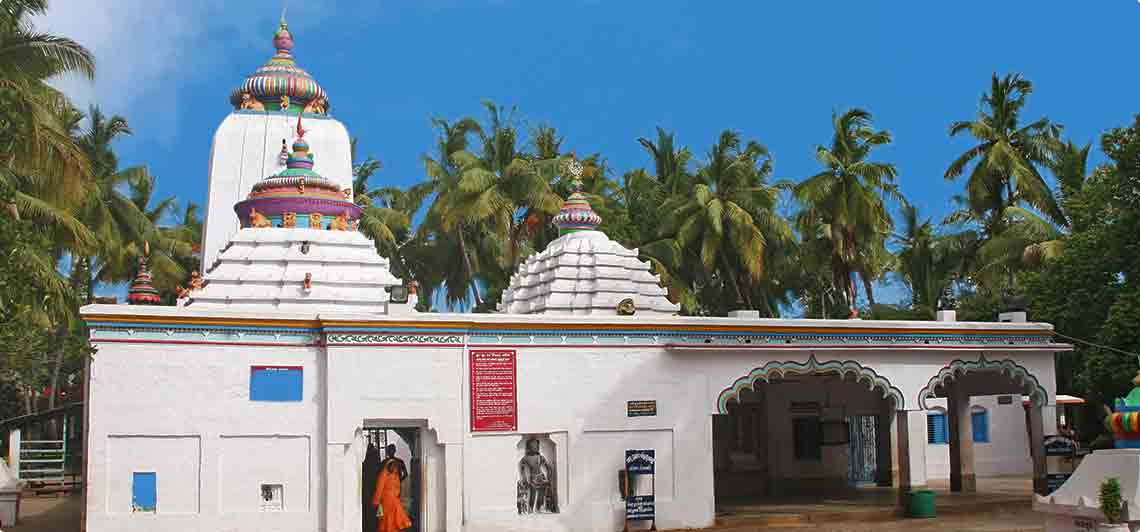
Ma Biraja Devi Shakti Peeth, Jajpur, Odisha,

Ma Birija Shakti Peetha., Jajpur, Odisha
Biraja Kshetra is not just a part of Shakti Peeths but also finds mention in the ancient scripture Skanda Purana as the sacred place which cleanses the pilgrims of their sins. Goddess Birija, the presiding deity of Jajpur has glorious antiquity. She is not only worshipped as Adishakti, or primeval power but is also an integral part of the social, religious, and cultural life of people of Odisha. And all this makes it one of the most visited pilgrimage sites in Odisha.
Sharing below some pointers to keep in mind for when you plan your Biraja Devi Shakti Peeth darshan trip. Also photography inside the sanctum sanctorum or garbhgriha is not allowed, so please be mindful of this and instructions provided for the visitors.
Getting There
Nearest Airport: Bhubaneswar
(Distance from Bhubaneswar is roughly 125 KM, you can hire a taxi from Bhubaneswar)
By Road and by Train: Jajpur is well connected by road and rail network with major cities of Odisha. Being an important junction of the East Coast Railways, many express trains do have stoppages at the Jajpur Keonjhar Station
Where to Stay: Jajpur has several budget hotels & lodges around the Biraja Khetra. There are a few good luxury hotels as well. I stayed at the newly operational Jajati Courtyard in Jajpur, which is a lovely property with nice service and warm staff. Alternately you can stay at Bhubaneswar.
This trip to Maa Biraja Shakti Peetha was part of a familiarization trip organized for travel writers by the Jajpur District Administration, in association with HACT Jajpur. The views expressed here are as always, my own.
Hope you enjoyed reading this post on Ma Biraja Devi Shakti Peeth and her religious and socio-cultural importance for all who worship her. I would love to read your thoughts on this post and if you have visited this Shakti Peeth, I would love to read about your experience. You can share your thoughts in the comment box below.

2 comments
Fascinating write up, enjoyed reading the details behind Sati immolation, only vaguely knew about the story. Also reading about Biraja Devi Shakti Peeth for the first time. So many interesting facts from our scriptures mentioned here…well researched and written.
Nicely written. Creating awareness about this shakti peeth. Jai Mata Biraja Devi.